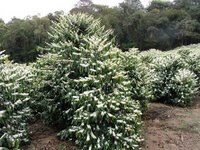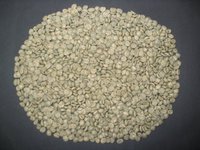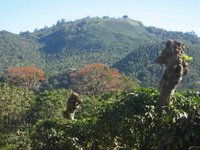Coffee Bean Types
There are two main species of the coffee plant. Coffea arabica is the older of them. It is thought to be indigenous to Ethiopia, but as the name implies it was first cultivated on the Arabian Peninsula. It is more susceptible to disease, and considered by professional cuppers to be greatly superior in flavor to Coffea canephora (robusta), which contains about twice as much caffeine—a natural insecticide (paralyzes and kills some of the insects that attempt to feed on the plant) and stimulant— and can be cultivated in environments where arabica will not thrive. This has led to its use as an inexpensive substitute for arabica in many commercial coffee blends such as Folgers, Maxwell House and almost all instant coffee products. Compared to arabica, robusta tends to be more bitter, with a telltale "burnt rubber" aroma and flavor. Good quality robustas are used as ingredients in some espresso blends to provide a better "crema" (foamy head), and to lower the ingredient cost. In Italy many espresso blends are based on dark-roasted robusta. Arabica coffees were traditionally named by the port they were exported from, the two oldest being Mocha, from Yemen, and Java, from Indonesia. The modern coffee trade is much more specific about origin, labeling coffees by country, region, and sometimes even the producing estate. Coffee aficionados may even distinguish auctioned coffees by lot number. The largest coffee exporting nation remains Brazil, but in recent years the green coffee market has been flooded by large quantities of robusta beans from Vietnam [2], due to low costs and to financing provided by the World Bank indirectly through the French Government. Many experts believe this giant influx of cheap green coffee led to the prolonged pricing crisis from 2001 to the present. In 1997 the "c" price of coffee in New York broke US$3.00/lb, but by late 2001 it had fallen to US$0.43/lb. Robusta coffees (traded in London at much lower prices than New York's Arabica) are preferred by large industrial clients (multinational roasters, instant coffee producers, etc.) because of their lower cost. One unusual and very expensive variety of robusta is the Indonesian Kopi Luwak and the Philippine Kape Alamid. The beans are collected from the droppings of the Common Palm Civet, whose digestive processes give it a distinctive flavor. Coffee Bean Varieties Coffee beans from two different places usually have distinctive characteristics such as flavor (flavor criteria includes terms such as "citrus-like" or "earthy"), caffeine content, body or mouthfeel, and acidity. These are dependent on the local environment where the coffee plants are grown, their method of process, and the genetic subspecies or varietal. Unroasted coffee beans of the Coffea arabica variety, from Brazil Some well-known arabica coffees include:
Coffees are often blended for balance and complexity, and many popular blendings exist. One of the oldest traditional blends is Mocha-Java, combining beans of the same name. The chocolate flavor notes peculiar to Mocha gave rise to the popular chocolate-flavored beverage, the Cafe Mocha, which may have been invented in circumstances where no Mocha beans were available. Nowadays, the Mocha-Java blend is often blended with some other varieties to provide variety. In addition to those blends sold commercially, many coffee houses have their own signature "house blends". "Ethical coffee" Shade trees in Orosí in Costa Rica. In the background (red) shade trees and in the foreground pruned trees for different periods in the growth cycle. A number of classifications are used to label coffee produced under certain environmental or labor standards. So-called Ethical coffee is produced or traded under specific conditions and guidelines, which are generally more environmentally friendly or economically equitable to the producers.
|






Comments on "Coffee Bean Types"
post a comment<< Home - all over coffee